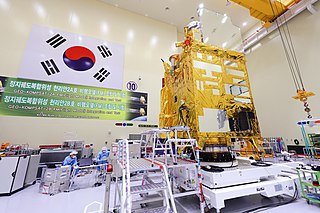
Arianespace SA is a French company founded in 1980 as the world's first commercial launch service provider. It is the operator of two different launch vehicles: Vega, a small-lift rocket and Ariane 6, a medium or heavy-lift rocket, depending on configuration.

The Soyuz programme is a human spaceflight programme initiated by the Soviet Union in the early 1960s. The Soyuz spacecraft was originally part of a Moon landing project intended to put a Soviet cosmonaut on the Moon. It was the third Soviet human spaceflight programme after the Vostok (1961–1963) and Voskhod (1964–1965) programmes.

Kourou is a commune in French Guiana, an overseas region and department of France in South America. Kourou is famous for being the location of the Guiana Space Centre, the main spaceport of France and the European Space Agency (ESA). It is an administrative district in French Guiana and the main town there.

The Guiana Space Centre, also called Europe's Spaceport, is a spaceport to the northwest of Kourou in French Guiana, a overseas region of France in South America. Kourou is located approximately 500 kilometres north of the equator at a latitude of 5°. In operation since 1968, it is a suitable location for a spaceport because of its near equatorial location and open sea to the east and north.

Vega is an expendable small-lift launch vehicle operated by Arianespace, produced by Avio, and jointly developed by the Italian Space Agency (ASI) and the European Space Agency (ESA). Development began in 1998 and the first launch took place from the Guiana Space Centre on 13 February 2012. It is the 8th most launched small lift launch vehicle in history. The final flight of the rocket is scheduled for September 2024, after which the vehicle will be replaced by the improved Vega C, already in use.

The Meteosat series of satellites are geostationary meteorological satellites operated by EUMETSAT under the Meteosat Transition Programme (MTP) and the Meteosat Second Generation (MSG) program.

European Remote Sensing satellite (ERS) was the European Space Agency's first Earth-observing satellite programme using a polar orbit. It consisted of two satellites, ERS-1 and ERS-2, with ERS-1 being launched in 1991.

Sinnamary is a town and commune on the coast of French Guiana, between Kourou and Iracoubo. Sinnamary was the second French settlement founded in French Guiana: the town was founded in 1664.
The European Space Tracking (ESTRACK) network consists of a number of ground-based space-tracking stations belonging to the European Space Agency (ESA), and operated by the European Space Operations Centre (ESOC) in Darmstadt, Germany. The stations support various ESA spacecraft and facilitate communications between ground operators and scientific probes such as XMM-Newton, Mars Express, BepiColombo, Gaia. Similar networks are run by the USA, China, Russia, Japan, and India.

Soyuz-2 is a modernized expendable medium-lift launch vehicle and the seventh major version in the Soyuz family. It includes key enhancements over its predecessors including improved engines along with digital flight control and telemetry systems, enabling launches from fixed platforms and the use of large payload fairings.

PoSAT-1, the first Portuguese satellite, was launched into orbit on 26 September 1993, on the 59th flight of the Ariane 40 launch vehicle. The launch took place in the Centre Spatial Guyanais, French Guiana. About 20 minutes and 35 seconds after launch, at an altitude of 807 km, PoSAT-1 separated itself from the launch vehicle.
The DirecTV satellite fleet is a group of communications satellites located at various geostationary orbits that DirecTV uses for their satellite television service and HughesNet internet service. The "DirecTV" prefix in their names has been changed to "T".

French Guiana is an overseas department and region of France located on the northern coast of South America in the Guianas and the West Indies. Bordered by Suriname to the west and Brazil to the east and south, French Guiana covers a total area of 84,000 km2 (32,000 sq mi) and a land area of 83,534 km2 (32,253 sq mi), and is inhabited by 295,385 people.

Chollian, also known as Communication, Ocean and Meteorological Satellite 1 (COMS-1), was a South Korean satellite which was launched on 26 June 2010 and began operations on 1 April 2011. It was operated by the Korea Aerospace Research Institute, who used it for communication, oceanography, and meteorological observation.

Soyuz at the Guiana Space Centre was a European Space Agency (ESA) programme that operated Soyuz-2 launch vehicles at the Guiana Space Centre (CSG). It provided Arianespace with a medium-lift launch vehicle alongside the light-lift Vega and heavy-lift Ariane 5. The rocket was marketed by Starsem a joint venture of ArianeGroup, Arianespace, Progress Rocket Space Centre and Roscosmos.
Intelsat 907 was a communications satellite operated by Intelsat.

Miura 5 is a two-stage European orbital recoverable launch vehicle currently under development by the Spanish company PLD Space. In a standard two-stage configuration, it will have a length of 34 m, be capable of inserting 1000 kg of payload into a low Earth orbit (LEO), featuring an optional kick stage that can circularize the orbits of satellites.
Weber-OSCAR 18 is an American amateur radio satellite.
Starlette and Stella are nearly identical French geodetic and geophysical satellites. Starlette was launched on 6 February 1975 and Stella on 26 September 1993. Starlette was the first passive laser satellite developed.













